Echinacea
By Debs Cook
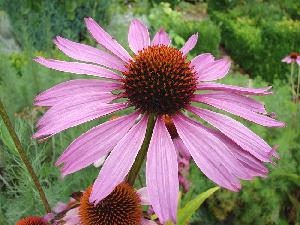
Echinacea purpurea
Winter is finally here, and if you haven't already been boosting your immune system, now is the time to do so!
This month I'm looking at Echinacea, or the purple coneflower as some of you may know it. Echinacea features in many winter remedy chests across Europe.
E. purpurea is the best known and researched herb for stimulating the immune system, and is the one grown on a commercial level for use in many herbal remedies and supplements. It is sometimes combined with E. angustifolia.
One of my favourite places to see echinacea is the The Herb Garden in Hardstoft, Chesterfield, Derbyshire. They have one of the national collections of echinacea which is well worth looking at in the late summer months.
History
Echinacea derives its name from the Greek word for hedgehog, 'echinos'.
Native American Indians such as the Cheyenne, Sioux and Comanche used echinacea as an antiseptic and to treat snakebites, toothaches, sore throat and even smallpox.
The early American settlers adopted the therapeutic uses of echinacea from the Indian tribes, and brought it to Europe in the 1700's and it has been used as a herbal remedy in the United States ever since.
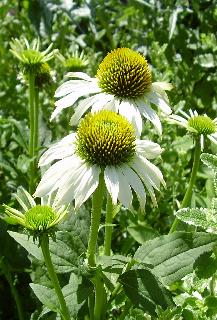
'White Swan'
White Swan doesn't grow as tall as other echinacea varieties making it a good medium height plant for the border.
In 1870, Dr HCF Meyer rediscovered echinacea whilst working amongst the native Indians of Nebraska, and later introduced it to a doctor in Europe, who described echinacea as a herb that could be used for treating nearly every sickness known to man. Echinacea was also found to be the secret ingredient in many tonics and blood purifiers of the era.
Historically, echinacea hasn't featured in that many cultures and, even in Chinese medicine, echinacea has only been used in their remedies over the past 20 to 30 years!
Folklore
Although echinacea has many folk names - Purple Coneflower, Black Sampson, Sampson Root, Hedgehog, Red Sunflower, Snakeroot, Scurvy Root, Indian Head and Comb Flower - there seems to be little folk lore surrounding the plant. This, I think, is mainly due to the fact that Echinacea did not become widely known in Europe until around the 1930's, so myths and old wives tales have never really formed around this herb. This may account for the ease that this herb found a use in the world of medicine! The only mythical/folklore information that I could find is once again from the native Indians of the American Plains, who used it as an offering to the 'spirits'.
Description
A member of the aster or daisy family, Echinacea is a native of the prairies of North America but is also widely cultivated in Europe. It is a perennial herb which grows up to a metre in height, depending on the variety. Its three main varieties are E. angustifolia, which is now an endangered species in its natural habitat, E. pallida, which is not as medicinally useful as the other varieties, and E. purpurea, the variety most often used commercially.
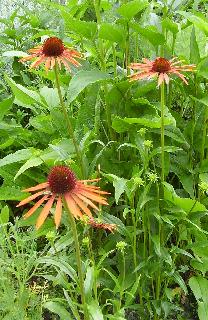
'Art's Pride'
Arts Pride is a stunning hybrid which is derived from a yellow echinacea (E. paradoxa) and a pink Echinacea (E. purpurea), and has soft orange flowers with a red tint.
Echinacea's have simple rough stems, which are hollow near the base and thicken slightly close to the flower head. The leaves are elongated, slightly elliptical with entire margins and are covered with tiny coarse hairs. The flowers central cone, from where the coneflower name derives, looks a little like a teasel, surrounded by rough hairy bracts, which are in actual fact hundreds of tiny individual flowers.
As well as the more common white, pink and purple colours, Echinacea now comes in beautiful orange hues. One of the first released of these orange varieties and the easiest to find is 'Arts Pride'. It has beautiful orange flowers that are striking for the flower bed as well as the herb bed, growing up to 60cm in height. This variety also has a delightfully sweet, orange blossom honey fragrance.
Growing
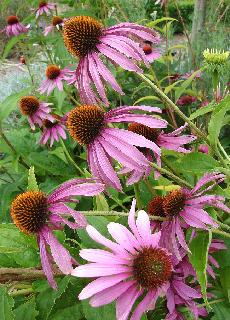
'Coneflower'
Not as effective medicinally as other Echinacea, but it makes a delightful specimen plant.
Echinacea prefers a sunny location with nice fertile soil. If your soil isn't particularly fertile, work in a little compost and something like organic chicken manure. Well-drained soil is a must. If your soil is very moist you'll need to make sure the area you're planting in has good drainage, or better still, grow echinacea in a raised bed. New plants and seedlings will need to be watered until they are established. Echinacea plants are available in most herb nurseries and garden centres. In fact you're more likely to find them amongst the flowering perennials in garden centres than in the herb section!
Propagating echinacea is child's play; as it is easy to grow from seed. Sow the seeds in spring, as soon as the soil can be worked, and when you still expect another frost or two. Once the seedlings are 2.5cm high, thin the plants out so that they are 40 -50cm apart. Alternatively, you can plant your seeds in the late summer/early autumn, as long as it's before the first frosts. Planting before the frosts gives the plants enough time to become established, and although they won't come to bloom the first year when you plant them this late, they will give you a longer flowering period the following year.
Regular weeding is important because echinacea doesn't compete well with weeds, but other than that, the plants require very little in the way of maintenance. The plants will flower from June until late October in most areas and will be one of the last plants in your garden to go die back in the winter. Plants can also be propagated through division, by taking cuttings of young shoots in spring.
General Use
The main use for echinacea is medicinal but it also makes a good cut flower and specimen plant for the garden. The flowers can be cut and dried for use in dried flower arrangements and Echinacea is also a useful source of nectar for butterflies and bees. The seed heads can be left to help feed the birds in winter. You'll also find echinacea in most supermarkets in the herb tea section where it seems to be a popular choice for blending with fruits such as orange and raspberry to make refreshing herbal brews.
Medicinal Use
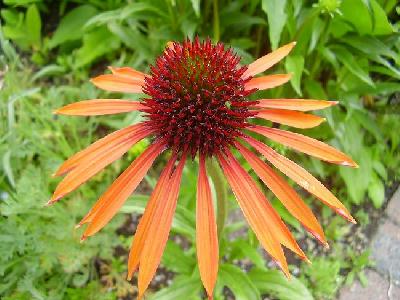
Echinacea contains volatile oil, alkamides, caffeic acid esters, echinolone and also copper, iron, tannins, protein, fatty acids and vitamins A, C, and E. It is used to stimulate and strengthen the immune system and also has superb antibacterial, antiviral, anti-fungal and anti-inflammatory properties and is used to treat colds and upper respiratory tract infections.
Research indicates that Echinacea taken during the winter months can reduce susceptibility to colds and reduce the length and severity of cold symptoms. It should be taken at a relatively low dose on an ongoing basis to boost the immune system or at a higher dose at the first signs of a cold developing. As well as for treating colds, echinacea can be used to treat acne, cold sores, chilblains, earache, mild asthma and urinary and fungal infections. In health food shops you can find echinacea in cream, capsule and liquid form. The liquid form is invariably a tincture. It can also be purchased in toothpaste. Echinacea is often mixed with other beneficial herbs such as elderberry and golden seal.
Caution: Do not take during pregnancy or breast-feeding. Not suitable for children under the age of 6 years.
Echinacea is generally well-tolerated and any side effects are rare.
